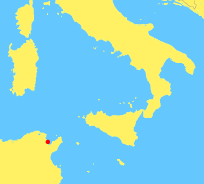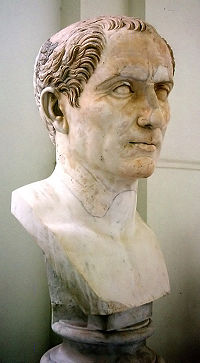Third Punic War
|
||||||||||||||||||||||||||||||
|
||||||||||||||||||||||||||||||
|
||||||||||||||||||||||||||||||
The Third Punic War (149 BC to 146 BC) was the third and last of the Punic Wars fought between the former Phoenician colony of Carthage, and the Republic of Rome. The Punic Wars were named because of the Roman name for Carthaginians: Punici, or Poenici.
The war was a much smaller engagement than the two previous Punic Wars and primarily consisted of a single main action, the Battle of Carthage, but resulted in the complete destruction of the city of Carthage, the annexation of all remaining Carthaginian territory by Rome, and the death or enslavement of the entire Carthaginian population. The Third Punic War ended Carthage's independent existence.
Contents |
Background
In the years between the Second and Third Punic War, Rome was engaged in the conquest of the Hellenistic empires to the east (see Macedonian Wars, Illyrian Wars, and the Roman-Syrian War) and ruthlessly suppressing the Iberian people in the west, although they had been essential to the Roman success in the Second Punic War. Carthage, stripped of allies and territory (Sicily, Sardinia, Hispania), was suffering under a huge indemnity of 200 silver talents to be paid every year for 50 years.
According to Appian the senator Cato usually finished his speeches on any subject in the Senate with the phrase ceterum censeo Carthaginem esse delendam, which means "Furthermore, it is my opinion that Carthage must be destroyed". He was opposed by the senator Publius Cornelius Scipio Nasica Corculum, who favoured a different course, one that would not destroy Carthage, and who usually convinced the Senate.
The peace treaty at the end of the Second Punic War required that all border disputes involving Carthage be arbitrated by the Roman Senate and required Carthage to get explicit Roman approval before going to war. As a result, in the fifty intervening years between the Second and Third Punic War, Carthage had to take all border disputes with Rome's ally Numidia to the Roman Senate, where they were decided almost exclusively in Numidian favour.
In 151 BC, the Carthaginian debt to Rome was fully repaid, meaning that, in Punic eyes, the treaty was now expired, though not so according to the Romans, who instead viewed the treaty as a permanent declaration of Carthaginian subordination to Rome akin to the Roman treaties with its Italian allies. Moreover, the retirement of the indemnity removed one of the main incentives the Romans had to keep the peace with Carthage - there were no further payments that might be interrupted.
The Romans had other reasons to conquer Carthage and her remaining territories. By the middle of the second century BC the population of the city of Rome was about 400,000 and rising. Feeding the growing populace was becoming a major challenge. The farmlands surrounding Carthage represented the most productive, most accessible and perhaps the most easily obtainable agricultural lands not yet under Roman control.
The course of war
In 151 BC Numidia launched another border raid on Carthaginian soil, besieging a town, and Carthage launched a large military expedition (25,000 soldiers) to repel the Numidian invaders. As a result, Carthage suffered a humiliating military defeat and was charged with another fifty year debt to Numidia. Immediately thereafter, however, Rome showed displeasure with Carthage’s decision to wage war against its neighbour without Roman consent, and told Carthage that in order to avoid a war it had to “satisfy the Roman People.” The Roman Senate then began gathering an army. After Utica defected to Rome in 149 BC, Rome declared war against Carthage. The Carthaginians made a series of attempts to negotiate with Rome, and received a promise that if three hundred children of well-born Carthaginians were sent as hostages to Rome the Carthaginians would keep the rights to their land and self-government. Even after this was done, however, the Romans landed an army at Utica where the consuls demanded that Carthage hand over all weapons and armour. After those had been handed over, Rome additionally demanded that the Carthaginians move at least ten miles inland, while the city itself was to be burned. When the Carthaginians learned of this they abandoned negotiations and the city was immediately besieged, beginning the Third Punic War. The Carthaginians endured the siege starting c.149 BC to the spring of 146 BC, when Scipio Aemilianus took the city by storm.
Aftermath
Many Carthaginians died from starvation during the later part of the siege, while many others died in the final six days of fighting. When the war ended, the remaining 50,000 Carthaginians, a small part of the original pre-war population were, as was the normal fate in antiquity of inhabitants of sacked cities, sold into slavery by the victors. The city was systematically burned for somewhere between 10 and 17 days; the city walls, its buildings and its harbour were utterly destroyed.
The remaining Carthaginian territories were annexed by Rome and reconstituted to become the Roman province of Africa. The site of Carthage was rebuilt and rededicated as a Roman city and would later become one of the main cities of Roman Africa.
That Roman forces then sowed the city and surrounding countryside with salt to ensure that nothing would grow there again is almost certainly an apocryphal story and a 20th century invention.[1] Contemporary accounts show that the land surrounding Carthage was declared ager publicus and that it was shared between local farmers, and Roman and Italian ones. North Africa soon became a vital source of grain for the Romans. Roman Carthage was the main hub transporting these supplies to the capital. The fact that Rome came to rely on North African grain as quickly as she did after conquering Carthage makes any notion that she might have destroyed Carthaginian farmlands quite doubtful.
In January 1985, Ugo Vetere, the mayor of Rome, and Chedly Klibi, the mayor of Carthage, signed a symbolic friendship and collaboration pact, "officially" ending the conflict between their cities.[2]
References
- ↑ Ridley, R.T., "To Be Taken with a Pinch of Salt: The Destruction of Carthage," Classical Philology vol. 81, no. 2 (1986).
- ↑ New York Times Retrieved 15 September 2008
External links
|
|||||||||||||||||

